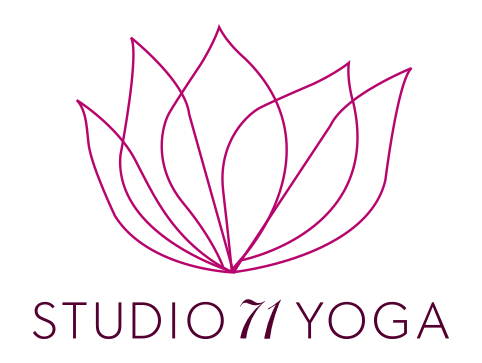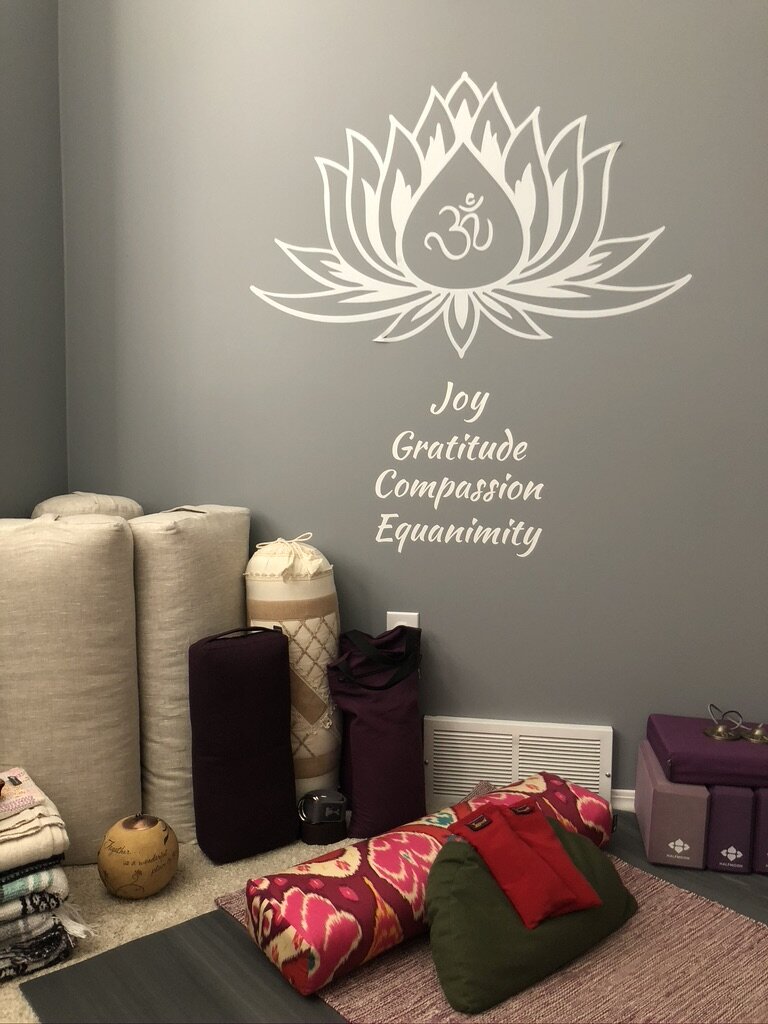A few years ago, during a live, virtual class on Zoom, a student inquired about the symbol in the centre of the lotus on the wall of my yoga space (see photo below). I replied that this was the symbol Om, to which the student replied, “What a complicated symbol for something so simple.” I mentioned that Om was much more complex than it appeared and that I could talk about it at greater length someday. Today is as good a day as any.
The Yoga tradition and teachings originating in the subcontinent of India span over five millennia. The metaphysical complexities associated with the syllable Om are deeply layered, and many scholarly works expound on the richness and sophistication of this mantra (chant). Suffice it to say that many academics have made this their life work.
Below is my not-so-scholarly attempt at explaining the meaning of Om.
Om, both a sound and a symbol rich in meaning and depth, is often chanted at the beginning and end of a yoga class, sometimes three times as a way of acknowledging associated triads some of which are:
Time: past, present and future
Divinity: creation, preservation and transformation
Spirit: immortality, omniscience and joy
The Sanskrit syllable Om is said to be the origin of all sounds. Sound is a form of energy and vibration, and Om is thus considered to be the primordial vibration from which all else emerged. With roots in Hinduism, the widely recognized Om sound is also found in Buddhism, Sikhism, and Jainism. In Hinduism, Om refers to Atman (soul, self within) and Brahma (the Absolute, the nature of truth, ultimate reality, the entirety of the universe).
Reverend Jaganath Carrera, a longtime disciple of Sri Swami Satchidananda, states the following:
“The identity of primordial sound with God as the creative force of the universe is not limited to Raja Yoga. It is a principle found in many spiritual traditions. The Bible declares, “In the beginning was the Word, and the Word was with God and the Word was God” (John 1.1). The Rig Veda, one of the most ancient scriptures in the world, contains a similar passage: “In the beginning was Brahman (God) and with Brahman was shabda (primordial sound) and shabda was truly the Supreme Brahman.”
The mystical sound Om, the oldest and one of the shortest Vedic mantras known to the ancient sages of India, is considered by many in the contemporary yoga world to be a sacred syllable, a sacred sound, a sacred single-syllable mantra. Sometimes Om is chanted 108 times (see below).
What is perhaps less known among contemporary yoga practitioners is that the Om syllable contains three constituent parts/letters: A + U + M. When the A and U are combined forming a long O sound, the chant typically sounds like, “Aaaaaaauuuuuummmmmm…”
As mentioned above, the three parts of AUM represent the past, the present, and the future. They also symbolize the conscious (waking) state, the dream state, and the dreamless state (deep sleep) amongst other representations such as the triad of Divinity: Brahma (the creator), Vishnu (the maintainer), and Shiva (the destroyer) of the universe. In addition, there is a silent echo at the end of Om/AUM, described in the Mandukya Upanishad as the cessation of the visible world, tranquil, auspicious, without a second.
The most common written representation of the Om symbol ॐ is a ligature in standard Devanagari form, an ancient, left-to-right pseudo-alphabet writing system of South Asia, combining ओ (au) and chandrabindu (ँ, ṃ). This symbol resembles the number three with a looping tail, with the addition of a large dot placed above an upturned crescent.
The symbol for Om should be treated with respect. Having it tattooed on the body, or printed on clothing, mugs, or even a yoga mat where our feet might step on the symbol is disrespectful to many Hindus, yoga practitioners and others. It is also considered to be a form of cultural appropriation. Knowingly offending others in this way is a violation of ahimsa, or non-harming.
Since Om is the basic sound of the universe, the act of chanting Om acknowledges within us that we are symbolically and physically connected to nature, to all living beings, and to the universe.
When we chant Om the vibrations in the body can help us to focus, to relax, slowing down the nervous system, bringing a sense of calm to the mind as we move toward parasympathetic nervous system dominance.
I have found that live, virtual classes do not lend themselves very well to chanting Om together in a harmonious way. For this reason I have avoided leading chants of any kind during most of my current offerings. However, I do plan to return to chanting when in-person classes resume.
I will be posting my Fall 2021 schedule soon. For now live, virtual classes via Zoom will continue but hopefully there will be opportunities for us to gather in person in the not-too-distant future.
I hope you will join me virtually and/or in person.
“Aaaaaaauuuuuummmmmm…”


